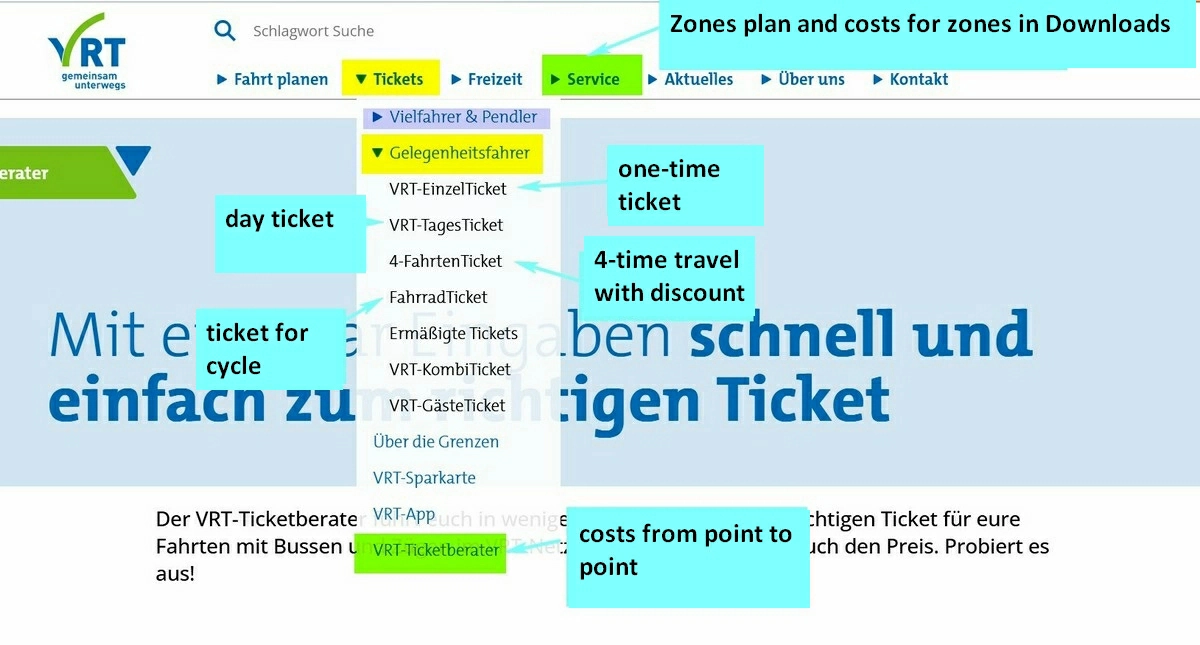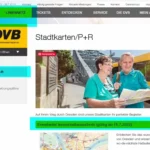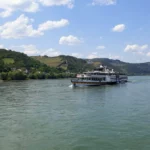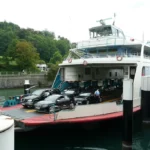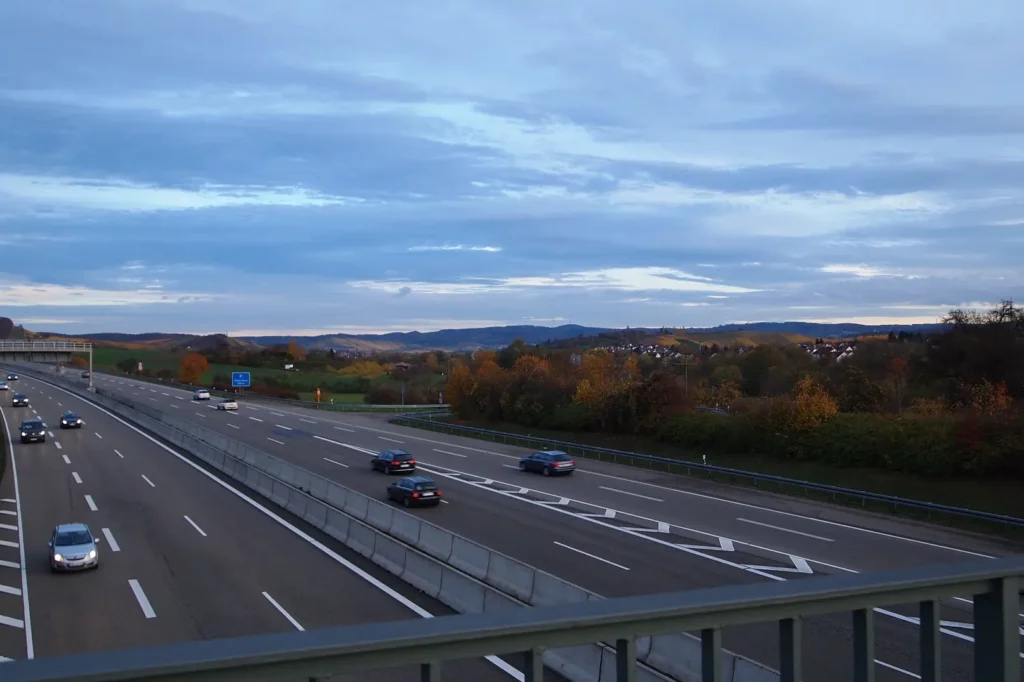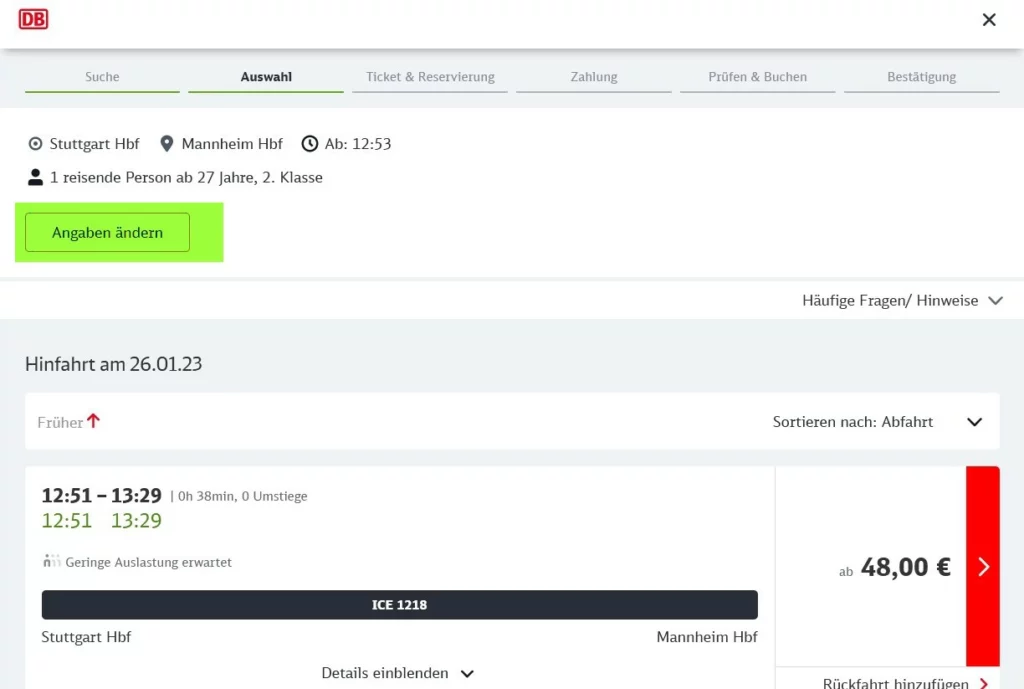Last Updated on 22/04/2023
The Deutsche Bahn website, of course, shows a lot, but still not everything. It does not show local public transport tariffs, and local tickets will also have to be bought from regional transport associations.
Federal railway fares apply if you are traveling to another region. Therefore, it may turn out that traveling with the family for 10 minutes to a neighboring city will take as much money as 40 minutes to a neighboring region, because Deutsche Bahn included children in an adult ticket, but local public transport system requires ticket for them.
Trains in Germany
Tourist and guest cards of Lake Constance
Public transport around Lake Constance
Germany by car
Welcome cards and public transport in Dresden and surroundings
In this topic, we will see how to deal with any transport website (they are all built on the same principle), what typical tickets are, how to count zones, how to find a map of lines, and how to buy a regional ticket from a machine.
Local public transport in Germany – websites
How to find
So, you found on bahn.de an inscription that some local tariffs apply on this segment. And in general, you are going to travel around the city and its environs, you need a map of lines and tariffs.
If we are talking about a major tourist city such as Berlin, Munich, Stuttgart, they usually have their own transport sites with at least English translation.
By the way, things are not so simple with Munich. It has www.mvv-muenchen.de – a general transport site for the region to various transport offices, and there is www.mvg.de – the transport of the city itself.
But how to search for sites for smaller cities and villages?
Firstly, when searching for a route, Deutsche Bahn can indicate in the price section whose fares are valid.
Secondly, you can see a map of transport associations in Germany. You type in Google “Karte der Verkehrsverbünde und Tarifverbünde in Deutschland” and get the desired map. You find the desired transport association, for example VRT for Trier, on the map, type it in the search and get the site www.vrt-info.de.
What to look for on the regional transport website
From the site you need:
zone map,
lines map and tariffs
after you select the desired line, it would be good to get a schedule.
Schedule and line plans
The first section we are interested in Fahrpläne.
Here we find Fahrplanauskunft – to get timetable online: enter your destination and departure point. It will help you only if you already know both.
You can only know the name of the city, but not the stops within it. The name of the stop can be found on sites of attractions (sections Anreise / Anfahrt) or on Google maps (zoom to the maximum and click on the picture with public transport).
If you did not find the names of the stops or want to build a plan with several points – you need Liniennetzkarte or Linienplan. They can be for the entire region (gesamt) or for cities. There are plans for download either in the Fahrpläne section, or in the Linienpläne section, or in the Service (Downloads) section.
You have determined which line is in the location you want. Now you can download the schedule for the desired line in the Linienfahrplan / Fahrplanseite (Fahrplanbuchseite) section by entering the line number.
Let’s look on the example of two random sites – Trier and Hamburg.
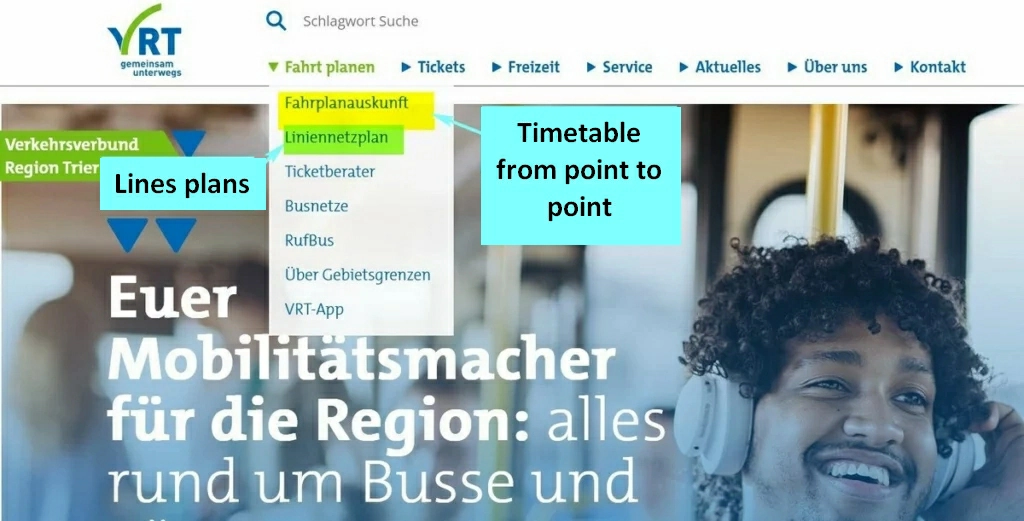
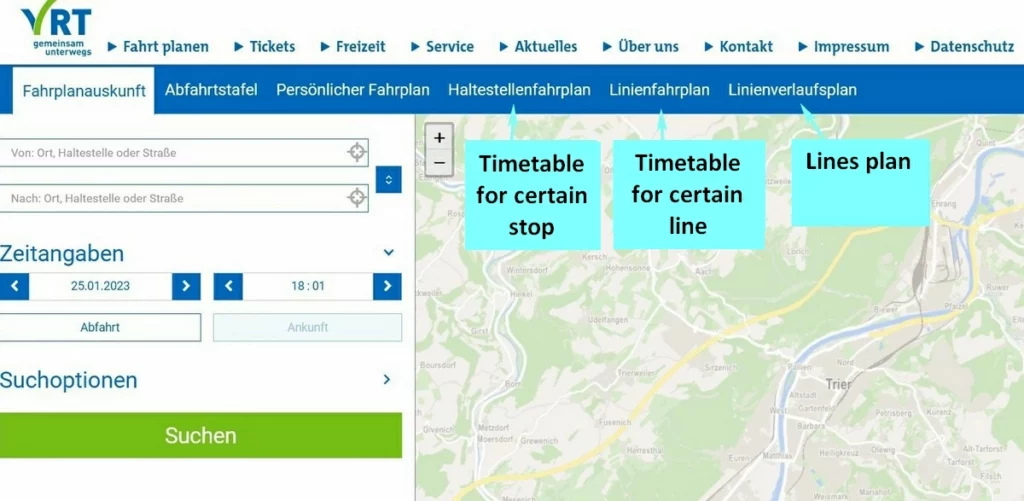

Tariffs and zones
Next section is Fahrscheine, aka Tickets, aka Tarife.
Tarifübersicht, Fahrscheinüberblick and similar combinations mean that this is a description of tariffs. Of course, without knowing the language, at first it will seem to you a terrible and incomprehensible jumble of words. At worst, Google translator and the like will help. But in all fare systems, essentially the same ticket options with slight differences.
To get started, you may need a Wabenplan or Zonenplan (sometimes Tarifgebiet) tariff cell plan and zones. Usually it is offered in the same section on a separate page, or inside the Tarif pages in the text or somewhere in the column on the right, or in the “Service” (“Download”) section.
If you take a single ticket from point to point, you may not need to calculate cells – the system itself will offer everything as it should. But if we are talking about complex routes or day tickets, then zones / cells are also needed.
When counting cells:
stops located on the border of the cells are considered not in your favor
cells cannot be cut obliquely
The Fahrscheinauskunft (or Fahrpreisermittlung, or Tarif-Navigator and similar variations) page lets you know which tickets you can buy on a particular route without the worry of counting cells.
Let’s see what this section looks like on our test sites, futher.
Ticket types
There are tickets for casual travelers (Gelegentheitsfahrer) and regular travelers (Vielfahrer).
Abos for regular travelers
From May 2023 you can buy a German ticket for 49 euros. It is monthly subscription, therefore you should read the conditions and do not forget to cancel it.
More about German ticket: German ticket for regional public transport Deutschland-Ticket
For the majority of those who regularly use regional transport, the German ticket will be more advantageous than the old abos. However, some of them have additional bonuses, so check other subscriptions before buying a German ticket.
Subscriptions are cheaper than one-time monthly cards. The greater the number of months paid at a time, the more profitable the subscription is usually. Subscriptions must be canceled in advance.
- ticket for one week (Wochenticket)
- ticket for one month – one time or as abo (Monatskarte or tickets with different names for different categories of citizens)
- a ticket for a year paid by months, for half a year or immediately for a year (Jahreskarte, 365-Ticket and other names)
Combined tickets or travel deals
Tickets with the words Entdecker, Erlebnis, Kombi usually mean special offers combining travel and visiting something.
Also, don’t forget to check the local guest’s / tourist card, they are sometimes very advantageous.
The transport network itself can offer a whole range of regional and inter-regional tickets. The more touristic a region is, the greater the tourist offer. But not all of them are beneficial for short trips. For example, you don’t need a Baden-Württemberg ticket to get to Ludwigsburg from Stuttgart.
For occasional travelers
- one-time single ticket (Einzelfahrschein) for one way trips from point to point,
- single tickets in «book» (Mehrfahrtenkarte, Streifenkarte) – the same as a one-time, only a few pieces or for several trips and cheaper by 10-25 percent. The ticket can also be named after the number of trips: 4-Fahrt, 10-Ticket;
- short trip ticket (Kurzstrecke, usually up to 4 stops). They can be sold as a “book” – Streifenkarte;
- day ticket for one or three days (Tageskarte, 3-Tageskarte),
- day ticket for groups – can be for 2, up to 5 or 6 people, from 10 people (Gruppen-, Minigruppen-, Partner-Tageskarte);
Anschlussticket makes it possible, if you have some kind of ticket for one zone, to get to another zone.
Don’t forget to also buy a ticket for children aged 6 to 14, dogs (often equated with children) and bicycles (Fahrradticket). Some networks sometimes allow these categories to ride for free – be sure to check this point (Mitnahme).
A special type of ticket for those traveling casually but regularly (that is, not to work, but, say, to the store once a week, the library once a month, etc.) is contact cards (the names are different everywhere). For a certain amount per year (about 5 euros), you get a card that must be scanned at the entrance and exit. The fare is automatically withdrawn from the account connected to the card. Traveling with such cards costs 20-25 percent less, but if you forget to scan, you will be charged the cost of a trip to all areas of the region.
Tickets on the VTR network. Here you can find out the price only in the Tarifberater section (from point to point) or download the full version in the Service section (zone plan and tariff table).
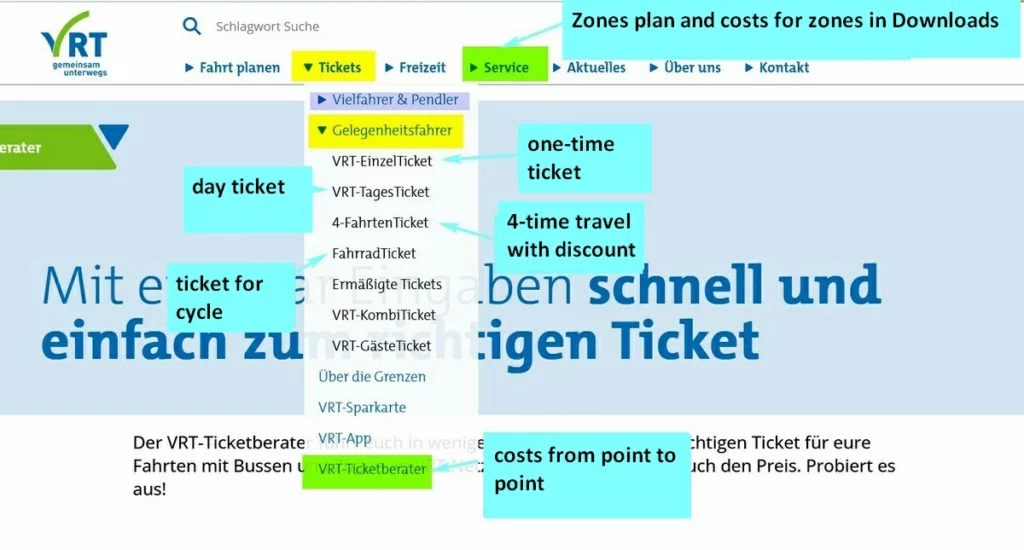
Tickets in Hamburg are in the Fahrkarten section with all fares. The fare zone plan is downloadable from the previous Fahrpläne section.

For those who do not want to study the zone plan, there is a link to Fahrplanauskunft, for some reason without a button in the menu, but as a link in the text. Here we already have the tourist card Hamburg Card. Its profitability must be checked, because there is an alternative day pass 9-Uhr-Tageskarte.
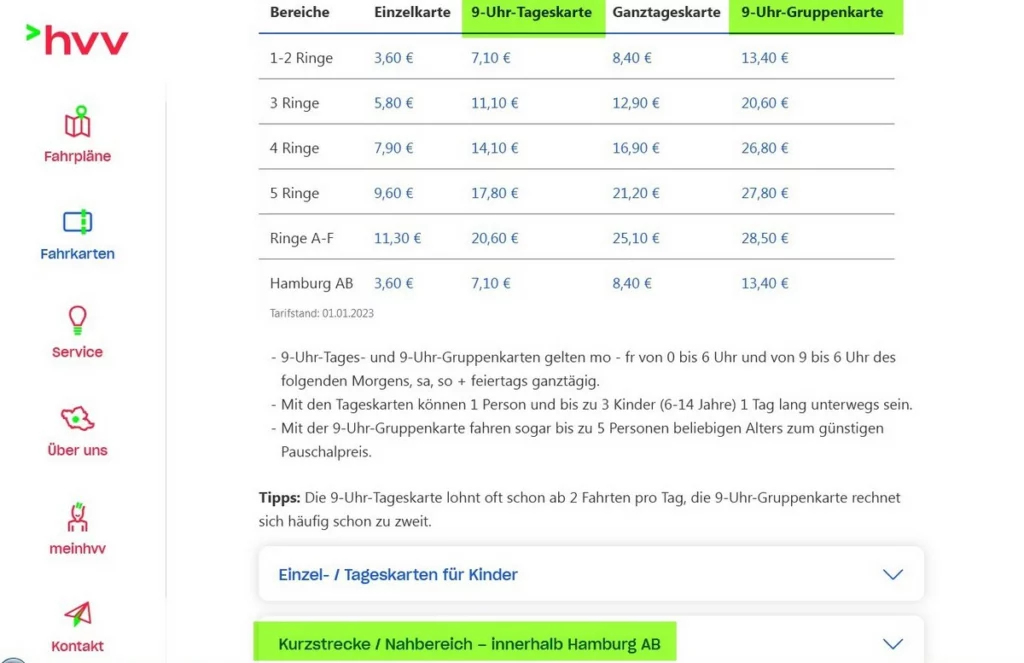
Where to buy tickets
Tickets are bought:
– through the app of this transport network
– through the app of the Deutsche Bahn. Please note that you can buy Handyticket for other people, but it is not transferable, but tied to a smartphone
– in vending machines at bus stops (if available)
– by the driver. Drivers only sell certain types of tickets (usually single tickets or daily tickets).
– in vending machines in buses (there are only in large cities)
Buying regional tickets from Deutsche Bahn vending machines
These machines are located at railway stations and S-Bahn stations. At bus and tram stops there are machines of local systems (if they are at all).
In the previous topic, we looked how to view the timetable and buy a ticket at the Deutsche Bahn level. Now let’s see how to buy local tickets in such machines. These are the right two windows: Gesamtes Angebot and Verkehrsverbund.
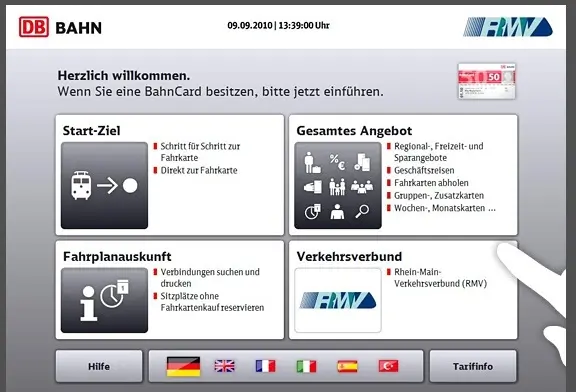
The “All offers” section (Gesamtes Angebot) contains various possible federal and local options, half of them are not suitable for the average tourist.
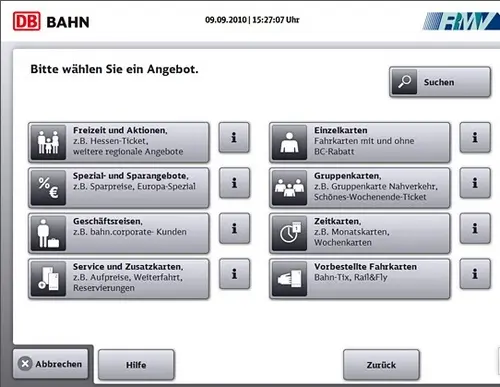
Follow me
Do you have any more questions? Use comments ⇓ or private communication form ⇨
First button on the left – regional offers (including the federal state ticket),
second button on the left – various cheap tickets for long trips, for example to another European country,
you probably won’t need the third
the fourth may be needed to purchase a ticket continuing the route or to reserve a seat.
In the right column, the second button is most interesting, where they offer a weekend ticket and tickets for federal states.
The Suchen button allows you to search for the desired special offer alphabetically, if you know what it’s called.
Local transport network section (Verkersverbund)
If you are traveling short distances or intending to travel around the area, it is better to use this section, as you will be offered not only a regular ticket, but all possible local options that you may not know about.
In the local system section, you can immediately select a popular preferential regional option (one-day ticket or federal state ticket) or enter the name of the station. The place of departure is automatically determined by the location, but it can be changed.
Before using the machine, look at the line map. It sometimes asks how exactly you want to go.
As a rule, a one-day ticket (Tageskarte) is cheaper than two tickets in one direction. A group day ticket in most cases makes sense already for two adults. You select the desired (that is, the cheapest) option, add, if necessary, a child ticket or bicycle pass (if it is free here and today, the system will not give it) and pay.
Theoretically, the machine accepts coins, banknotes and cards.
In practice, it may not take large banknotes if the change is too large, coins – if it is full, or cards – if something has happened to its brains or if it does not like the card. This usually means having small amounts of cash or using a smartphone app.
Some tickets in Germany need to be stamped (in small boxes at the entrance). This applies to tickets that are valid for a certain time or the price of which depends on the distance. In practice, this means that you need to compost tickets for the metro and for the Straßenbahn (tram), if there is no date and time (these are ticket book options). Land tickets (Bavarian, etc.) do not need to be stamped, but they must be signed.
Announcements at regional stations and trains
When we first arrived and did not understand German well, we were amused by one announcement on the train. As it turned out, there was little fun there, since it meant “stop on demand.” According to my observations, most foreigners ignore this announcement and then start rushing about.
Nur bei Bedarf – means you have to press a button if you want to exit
The constantly repeated announcement Zug wird geteilt (the last word is usually well heard) – says that you should ask the people around you if this half of the train is going where you need to go.
Zug endet hier says that the train will not go further. Please leave the train.
Zug fällt aus – train canceled
Zug (wird) umgeleitet – trains are running to bypass the affected area. Here, of course, you need to know how trains run in order to understand if you have a chance to bypass.
Ersatzbusse (werden) eingesetzt – bus instead of train. Look carefully: they are very inconspicuous and do not attract attention to themselves.
Verzögerungen im Betriebsablauf a designation for delays, usually during peak hours when too many people start to delay the departure.
Technische Störungen – usually these are jammed doors (10 minutes late), problems with traffic lights (10-20 minutes, but maybe an hour), problems with the railway tracks (unpredictable here).
Unfall mit Personenschaden – such an announcement speaks of people who have fallen under the train, which means a very long traffic violation.
Streckensperrung – complete closure of the site due to an accident or repair. Usually, instead of a train, in this case, it is proposed rail replacement service Schienenersatzverkehr.
Word Beeinträchtigungen (beantrachtigt) means that something negatively affects transport. For example, natural disasters. That is, you are offered to either put up with possible delays, or not to go.
How can you compensate for losses when the train is late
Feature of doors of old regional trains
Most of the old wagons have already been taken out of circulation, but you can still run into them. Climbing into them is inconvenient, and the door can become a whole problem and the reason for skipping the station.
How to open it:
1) wait for the train to stop completely,
2) press down on the handle with force until it stops,
3) without releasing the handle, push the door forward with force.

It is important not to rush and do everything consistently. Doors sometimes jam. Instead of pulling one door many times, try opening the next one. And the best way is to go out with other people.
More topics about #transport in Germany
Do you enjoy the site without cookies? This means that I work for you at my own expense.
Perhaps you would like to support my work here.
Or change your cookie settings here. I don’t use personalized ads

